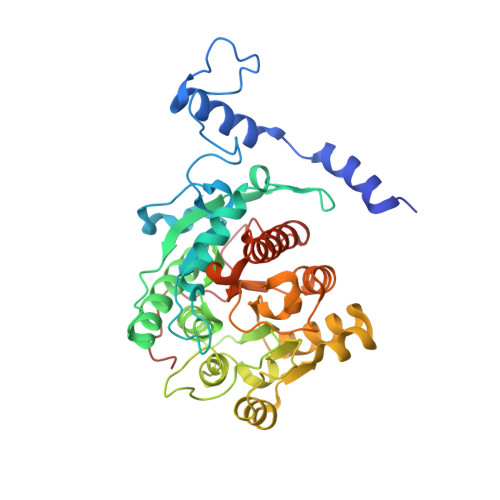Discovery of a Ni 2+ -dependent guanidine hydrolase in bacteria.
Funck, D., Sinn, M., Fleming, J.R., Stanoppi, M., Dietrich, J., Lopez-Igual, R., Mayans, O., Hartig, J.S.(2022) Nature 603: 515-521
- PubMed: 35264792
- DOI: https://doi.org/10.1038/s41586-022-04490-x
- Primary Citation of Related Structures:
7ESR, 7OI1 - PubMed Abstract:
Nitrogen availability is a growth-limiting factor in many habitats 1 , and the global nitrogen cycle involves prokaryotes and eukaryotes competing for this precious resource. Only some bacteria and archaea can fix elementary nitrogen; all other organisms depend on the assimilation of mineral or organic nitrogen. The nitrogen-rich compound guanidine occurs widely in nature 2-4 , but its utilization is impeded by pronounced resonance stabilization 5 , and enzymes catalysing hydrolysis of free guanidine have not been identified. Here we describe the arginase family protein GdmH (Sll1077) from Synechocystis sp. PCC 6803 as a Ni 2+ -dependent guanidine hydrolase. GdmH is highly specific for free guanidine. Its activity depends on two accessory proteins that load Ni 2+ instead of the typical Mn 2+ ions into the active site. Crystal structures of GdmH show coordination of the dinuclear metal cluster in a geometry typical for arginase family enzymes and allow modelling of the bound substrate. A unique amino-terminal extension and a tryptophan residue narrow the substrate-binding pocket and identify homologous proteins in further cyanobacteria, several other bacterial taxa and heterokont algae as probable guanidine hydrolases. This broad distribution suggests notable ecological relevance of guanidine hydrolysis in aquatic habitats.
- Department of Chemistry, University of Konstanz, Konstanz, Germany.
Organizational Affiliation:



















